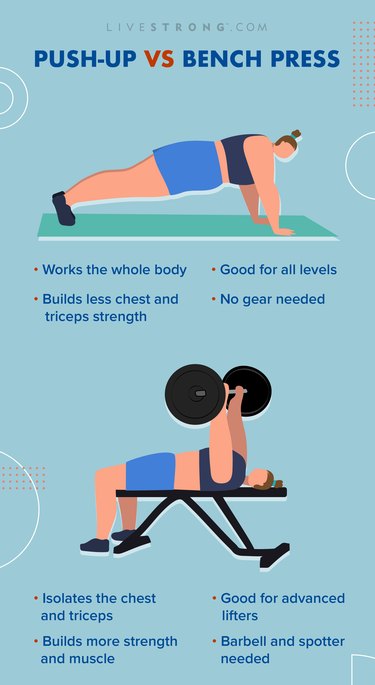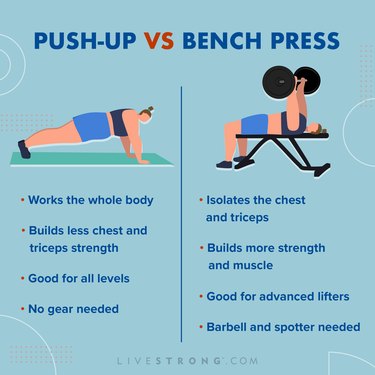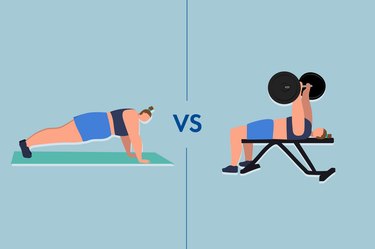



Bench presses and push-ups are the bread and butter of building stronger chest muscles, but when it comes to honing in on the inner and outer layers of your pecs, does one exercise outshine the other?
Studies show that the bench press develops your pecs to a greater degree than push-ups. For example, according to an October 2012 research from the American Council on Exercise (ACE), the barbell bench press is superior at activating the chest muscles compared with the push-up, pec deck machine, cable crossovers, chest press machine and dumbbell flys.
Video of the Day
But that's not to say that you should scrap push-ups altogether. There are pros and cons to both push-ups and bench presses, and the best chest exercise for you depends on your goals, strength level and the type of equipment you have.
Here, we break down the push-ups vs. bench presses debate, and explain how to incorporate both into your pec routine so get the strong upper body you're after.

Push-Up for Your Chest
The push-up is a body-weight exercise that starts in a high plank and involves lowering your chest toward the ground and then pushing your body back up to a high plank. It primarily works the middle and inner fibers of the chest, but it also targets the shoulders and triceps.
How to Do a Push-Up
- Begin in a high plank with your core and glutes engaged. Your shoulders should be stacked over your wrists and your hips should be in line with your head and heels.
- Bend at your elbows at about a 45-degree angle from your torso and lower your body toward the ground.
- On the way down, squeeze your shoulder blades together.
- When your chest hovers just above the ground (or however far down you can go), press into the ground and push your shoulder blades apart to return to the starting position.
Pros
Good for all levels: As a body-weight exercise, the push-up is excellent for people of all fitness levels. For example, beginners can modify the exercise and do a push-up on the wall while standing, on an elevated surface, like a bench or chair, or on their knees. More advanced exercisers can do single-arm or dive-bomber variations to test their stability and strength, and improve muscle strength and development.
"Push-ups have a lot more options for variations and modifications that the bench press doesn't to address postural imbalances or injuries someone might be dealing with," says certified personal trainer Mike Nielsen, CPT.
Doing different variations also allows you to work your pectoral muscles in a variety of ranges of motion, providing a greater stretch and contraction for the muscles, explains Theron Merrick, CPT.
Builds total-body strength: Push-ups are a full-body exercise; in addition to working your chest, they also target your shoulders, triceps and core, which are essential for improving your "pushing" strength and stability. These muscles are important for carrying out daily tasks, such as opening doors, lifting heavy objects and moving furniture across the room.
Improves overall fitness: There's no better indicator of overall strength and fitness than being able to push your own weight, and that's exactly what you're doing with a push-up.
People who were able to do more than 40 push-ups at a time were associated with a lower risk of cardiovascular disease compared with those who could do less than 10 push-ups, according to a February 2019 study in JAMA. This study suggests that doing push-ups can help increase both your cardiovascular fitness and strength.
Cons
Not as easy to progress: As you get stronger, you'll need to do more reps to continue building strength and avoid a plateau. But many of us don't have the strength to do multiple sets of push-ups (not to mention, it can get boring), so make sure to mix things up by trying out different push-up variations like a plyo, single-leg or diamond push-up.
Prone to aches and pains: If you're experiencing back, wrist, shoulder or elbow pain while doing push-ups, it's a sign that something in your form might be off or that you have an underlying joint issue. Make sure your elbows are tied closely to your sides to keep your shoulders safe and that you're bracing your core to prevent overarching your back.
Pain can also be a red flag that you're overdoing it. Doing push-ups every day can put you at risk for shoulder and wrist injuries so make sure to balance your workout routine with pulling exercises, like rows, biceps curls and plank pull-throughs.
Bench Press for Your Chest
A bench press is a chest exercise usually done on a weight bench or lying on the floor with a pair of dumbbells or a barbell. It primarily targets your inner and mid pectorals and triceps, but depending on the incline of your bench and your grip, you can zero in on specific areas of your pecs (more on this later).
How to Do a Bench Press
- Lie face-up on a flat bench with your eyes in line with the barbell. Your feet should be flat on the floor.
- Grip the barbell with your hands shoulder-width apart and lift it off the rack to position it directly over your shoulders. Pull your abs into your spine to avoid arching your lower back.
- Lower the barbell as far as you can with control or until it touches your chest and you feel a stretch in your chest muscles. Pause for a second in this position.
- Press the weight back to the top until your arms are fully extended.
Pros
Easy to progress: You can add weight plates to a barbell or choose a heavier set of dumbbells to make the exercise more difficult and effective at fatiguing your chest muscles compared with doing many reps of push-ups.
Targets the chest and triceps: The bench press is a chest and triceps exercise and, by isolating this muscles, can grow them to a higher degree than the push-up — or most any other chest exercise, for that matter.
Although the bench press is usually performed on a flat, horizontal surface, you can increase the difficulty of the exercise by adding a decline (30 degrees lower than a flat bench) or incline (45 degrees higher than a flat bench).
An incline bench, for instance, targets your upper pecs while a decline bench closes in on your lower pecs. Moreover, a neutral grip (palms facing each other) hones in on the upper and lower pecs, as well as your triceps, and a reverse grip (palms facing you) gives more focus to your upper pecs.
A March 2015 study in the European Journal of Sport Science found that doing the bench press at an incline of 35 to 45 degrees produces the most chest muscle activation compared with a flat or decline bench.
Large range of motion: The chest press offers a larger range of motion for your pecs compared with the push-up, per the October 2012 ACE study. This means that your chest muscles are able to fully contract and relax, improving their overall function and strength.
"If your main goal is developing a bigger and stronger chest, you'll get faster results with the bench press by lifting heavier loads," Nielsen says.
Cons
Higher injury risk: Compared with the push-up, the risk of injury with bench presses is higher because you're not only moving more weight, but you're moving weight above your head. Using a spotter, aka someone who can catch the weight, can help you prevent injury.
"You have to ask yourself some questions like: Are you using the bench press in a gym? Or are you working out at home? Do you have a spotter? These are some things you need to consider with the bench press that you don't have to think about with push-ups," Nielson says.
Plus, lifting too heavy or training the chest muscles beyond fatigue (not being able to do another rep) can lead to serious injury to the chest and shoulder muscles, according to a small 2019 study in the Journal of Surgical Orthopaedic Advances. So make sure you're allowing your chest muscles at least one full rest day in between workouts during the week.
Equipment needed: You need fitness equipment, including a bench, a barbell or other weights, to do bench presses at home. Although you can do bench presses lying down, you'll get the most chest activation using a bench.
Progressively loading your lifts is also key to get stronger, so you'll need to have a variety of weights and plates.
For safety's sake, only bench press with a barbell if you have a spotter with you.
How to Do the Push-Up and Bench Press for Your Chest
So push-ups or bench presses, do you have to really choose? If you have goals of building a stronger and bigger chest, you're ultimately going to get more out of the bench press than the push-up.
But doing push-ups can complement bench presses in a chest routine and are great for building overall full-body strength.
For example, if you're not able to go to the gym or are traveling, push-ups are a great alternative to chest presses — and you don't need equipment to do them. You can also do push-ups as part of your warm-up before you hit the bench or start your upper-body routine. Try adding a push-up to the world's greatest stretch or the inchworm from the high plank position.
Alternately, you can focus on bench presses one day a week and push-ups on another day so you work the "pushing" movement at different positions. Just make sure to change your workouts every 4 to 6 weeks to keep making progress and avoid hitting a strength and endurance plateau.
In need of ideas? Try this push-up and bench-press workout, courtesy of Nielsen.
- Warm-up: 10-25 push-ups (standard or knee push-ups)
- Bench press warm-up: 1 set of 10 reps (light weight)
- Bench press: 3 sets of 10 reps (weight should be heavy enough that reps 8, 9 and 10 should be hard)
- Push-up finisher: After bench press sets, do as many push-ups as you can.
Tip
Make the exercises more challenging by adding a tempo: Go slow on the way down and press up on an exhale, Nielson says.
More Great Chest Exercises
- JAMA: "Association Between Push-Up Exercise Capacity and Future Cardiovascular Events Among Active Adult Men"
- European Journal of Sport Science: "Influence of Bench Angle on Upper Extremity Muscular Activation During Bench Press Exercise"
- Journal of Surgical Orthopaedic Advances: "Acute Pectoralis Major Tears in Forward Deployed Active Duty U.S. Military Personnel: A Population at Risk?"
- American Council on Exercise: "Top 3 Most Effective Chest Exercises"


